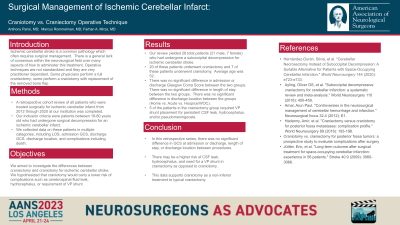Surgical Management of Ischemic Cerebellar Infarct
Friday, April 21, 2023

.jpg)
Anthony Parisi, MD
Neurosurgery Resident
University of Kentucky
Lexington, Kentucky, United States
ePoster Presenter(s)
Introduction: Ischemic cerebellar stroke is a common problem which often requires surgical management. There is a lack of consensus within the neurosurgery over administration of this treatment. Some surgeons perform a decompressive craniectomy while some perform a craniotomy with necrosectomy. Our study investigates if there are any notable differences between these two operative techniques.
Methods: We completed a retrospective review of patients who were treated surgically for ischemic cerebellar infarct from 2012 through 2020 at our institution. Our inclusion criteria were patients between 18-80 years old who had undergone surgical decompression for an ischemic cerebellar infarct. Main variables included admission and discharge GCS, LOS, discharge location, and complications.
Results: Our review yielded 28 total patients (19 male, 9 female) meeting inclusion criteria, 20 (75.8%) of whom underwent craniectomy, and 8 (24.13%) of whom underwent craniotomy. Average age was 52 years, not different between groups. Average LOS was 21.75 days for the craniectomy group and 18.13 days for the craniotomy group, not significantly different. Average admission GCS was 12.5 in the craniectomy group and 13.37 in the craniotomy group, not significantly different. Average discharge GCS was 11 in the craniectomy group and 14.75 in the craniotomy group, which was significantly different. Five patients died in the craniectomy group vs. 0 deaths in the craniotomy group. Five patients in the craniectomy group had persistent CSF leak, hydrocephalus, and/or pseudomeningocele vs. 0 in the craniotomy group.
Conclusion : In our retrospective series, there was no significant difference in admission GCS or LOS between groups. There was a significant difference in discharge GCS, CSF leak and/or hydrocephalus, and mortality in craniectomy as opposed to craniotomy. Our results suggest that craniotomy with necrosectomy is non-inferior, if not superior to decompressive craniectomy for ischemic cerebellar infarct. A larger multi-center study would be useful to further identify superiority.
Methods: We completed a retrospective review of patients who were treated surgically for ischemic cerebellar infarct from 2012 through 2020 at our institution. Our inclusion criteria were patients between 18-80 years old who had undergone surgical decompression for an ischemic cerebellar infarct. Main variables included admission and discharge GCS, LOS, discharge location, and complications.
Results: Our review yielded 28 total patients (19 male, 9 female) meeting inclusion criteria, 20 (75.8%) of whom underwent craniectomy, and 8 (24.13%) of whom underwent craniotomy. Average age was 52 years, not different between groups. Average LOS was 21.75 days for the craniectomy group and 18.13 days for the craniotomy group, not significantly different. Average admission GCS was 12.5 in the craniectomy group and 13.37 in the craniotomy group, not significantly different. Average discharge GCS was 11 in the craniectomy group and 14.75 in the craniotomy group, which was significantly different. Five patients died in the craniectomy group vs. 0 deaths in the craniotomy group. Five patients in the craniectomy group had persistent CSF leak, hydrocephalus, and/or pseudomeningocele vs. 0 in the craniotomy group.
Conclusion : In our retrospective series, there was no significant difference in admission GCS or LOS between groups. There was a significant difference in discharge GCS, CSF leak and/or hydrocephalus, and mortality in craniectomy as opposed to craniotomy. Our results suggest that craniotomy with necrosectomy is non-inferior, if not superior to decompressive craniectomy for ischemic cerebellar infarct. A larger multi-center study would be useful to further identify superiority.
